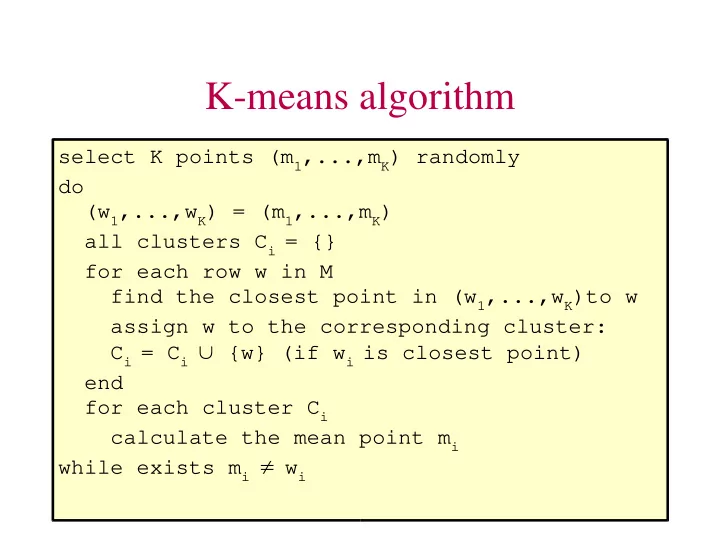

K-means algorithm select K points (m 1 ,...,m K ) randomly do (w 1 ,...,w K ) = (m 1 ,...,m K ) all clusters C i = {} for each row w in M find the closest point in (w 1 ,...,w K )to w assign w to the corresponding cluster: C i = C i ∪ {w} (if w i is closest point) end for each cluster C i calculate the mean point m i ≠ w i while exists m i
K-means clustering ● Input: M (set of points), K (number of clusters) m 1 ,...,m k (Initial centroids) ● Choosing K – Study the data – Measure how squared error decreases as more clusters are added ● Choosing centroids – Typically randomly
K-means clustering ● Pros: – Easy – Scalable ● Cons: – Works only for certain clusters – Sensitive to outliers and noise
K-means clustering
K-means clustering Bad initial points
K-means clustering Non-spherical clusters
Questions ● Using the euclidean distance one gets spherical clusters, what types of clusters does one get using the manhattan distance? ● If we assume that the K-means algorithm converges in I iterations, with N points and X characteristics for each point give an approximation of the complexity of the algorithm expressed in K,I,N and X ● Can the K-means algorithm be parallellized? if yes how?
Practical K-Means I want to cluster this class into 5 different clusters. Assume that I know: ● Your Age ● What row you are sitting in ● Wether you handed in the first assignment on time or not ● How many years you have studied at university Design a method to use K-means to create these clusters
DB Scan ● Density based clustering ● Connected regions with sufficiently high density ● Clusters with arbitrary shape ● Avoids outliers, noise
DB Scan - key concepts ● -neighbourhood – the neighbourhood within a radius of an object ● core object – an object is a core object iff there are more than MinPts objects in its -neighbourhood ● directly density reachable (ddr) – An object p is ddr from q iff q is a core object and p is inside the -neighbourhood of q
DB Scan - key concepts ● density reachable (dr) – an object q is dr from p iff there exists a chain of objects p 1 ,...,p n such that p 1 is ddr from p , p 2 is ddr from p 1 , p 3 is ddr from ... and q is ddr from p n . ● density connected (dc) – p is dc to q iff exist an object o such that p is dr from o and q is dr from o
DB Scan - How to use DB scan to cluster ● Idea: – If object p is density connected to q, then p and q should belong to the same cluster – If an object is not density connected to any other object it is considered as noise
DB Scan - How to use DB scan to cluster ● Naïve Algorithm: i = 0 How do you do this? do take a point p from M find the set of points P which are density connected to p if P = {} M = M / {p} else C i =P, i=i+1, M = M / P end ≠ while M {}
DB Scan - How to use DB scan to cluster ● More practical Algorithm: i = 0, Find the core points CP in M do How do you do this? take a point p from CP find the set of points P which are density reachable from p ∩ P) C i =P, i=i+1, CP = CP / (CP ≠ while CP {}
DB Scan - How to use DB scan to cluster find the set of points P which are density reachable from p C={p},P={p} do Remove a point p' from C Find all of the points X that are directly density reachable from p' C = C ∪ ( X \ ( P X)) ∩ P = P ∪ X ≠ while C {}
Questions ● Why is the density connected criterion useful to define a cluster, instead of density reachable or directly density reachable? ● For which points are density reachable symmetric? ● Express using only core objects and directly density reachable, which objects will belong to a cluster.
Practical db scan Try to use the db scan algorithm with the following parameters: MinPts: Eps: To determine if you are a core point, if you belong to a cluster.
Recommend
More recommend